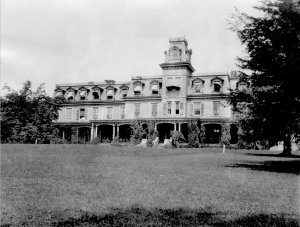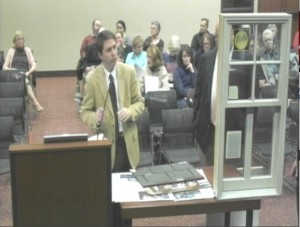The Louella Mansion is the most important building in downtown Wayne.
Whomever takes ownership of Louella inherits both a unique privilege and a great responsibility. A local developer has put forth a plan to convert the building into a 12-unit condominium complex, with an attached garage structure consisting of 24 bays. These plans have been presented at two Radnor Township Historic and Architectural Review Board (HARB) meetings, the most recent of which was on April 6. The residents of Louella Court, whose homes orbit the mansion’s east and north sides, have spoken out strongly regarding how the garage will alter their community. While they are rightfully focused on this single aspect, we cannot lose sight of possible changes to the mansion itself.
Built ca. 1865 by J. Henry Askin, the founder of the town, Louella was the largest and most prominent home in the area. Mr. Askin wanted to build a utopian community in Wayne, with a Presbyterian Church on Lancaster Pike (still standing) and a row of houses on Bloomingdale Avenue that looked similar to his own (most of which still stand). In the 1880s, Louella was expanded for re-use as a summer hotel, and a girl’s school used it during winter months. After this, it became a multi-unit residence, which it remains.
Unfortunately, Louella is not in the best condition today. When viewed up close, there are some obvious cosmetic flaws that need to be addressed. However, for a building of its age, Louella remains remarkably intact. One of its greatest original features are its windows, some of which reach to the floor, typical of the Second Empire style of the 1860s and ’70s. The windows are all the more remarkable when one considers that it was from these that Mr. Askin watched his town grow 140 years ago.
Windows are a major character-defining feature of any historic building, as outlined by the National Trust for Historic Preservation and even local groups: the Lower Merion Conservancy has just listed historic windows as their township’s #1 most threatened historic resource. Many do not realize the historic and environmental benefits of preserving windows, especially in light of incentives that falsely pronounce replacement windows as more environmentally conscious. The studies are in: replacing windows is far more wasteful than restoring them, and replacement detracts from a building’s historic character in a way that can never be regained.
Neither the developer nor his architects have indicated that they have even explored the option of restoring Louella’s existing windows, and possibly adding interior storm windows for increased efficiency. Instead, they have gone to great lengths to reproduce the “look” of what’s already there, having a window fabricator create a sample of a modern window that creates an appearance that is “virtually identical” to what already exists. “Virtually identical” doesn’t cut it. The very idea of respecting an old building is recognizing and appreciating its historic features, not by trying to make it look “new” again.
Another idea that was presented at the April 6 HARB meeting was of replacing the building’s slate mansard roof with asphalt shingles that are designed with fake shadow lines to mimic the appearance of slate. The developer mentioned that the shingles’ 40 year lifespan will be of benefit to the future homeowners. The mansion’s present slate roof has been in use for approximately 130 years (possibly more in some places). A new (or repaired) slate roof would require periodic maintenance, but in terms of the long-term durability and historic appropriateness, slate wins.
Louella is Wayne’s “Founder’s House,” a distinction that many towns uphold as their single most important historic building. And yet, the would-be developer of Louella has not gone as far as to hire an architect or consultant with any preservation experience. As far as their website would indicate, the architects chosen for the renovation of Louella have very little experience in working with existing buildings. If Louella does not deserve the careful and experienced attention of a preservation architect, then what does? (Preservation also makes good business sense: following the correct guidelines and restoring historic windows could lead the developer to significant historic preservation tax credits.)
As the HARB is only an advisory board, the township Board of Commissioners will have the final say on the proposal during their March 25 meeting. All Wayne residents need to realize the impact of this plan. Mr. Askin would probably be proud with the success of his town more than a century after he started it, but today we need to remember how it began, and respect the historic fabric that remains. If preservation is of importance to the new owners of Louella, the Radnor Historical Society graciously offers its support and guidance in planning for Louella’s future.


